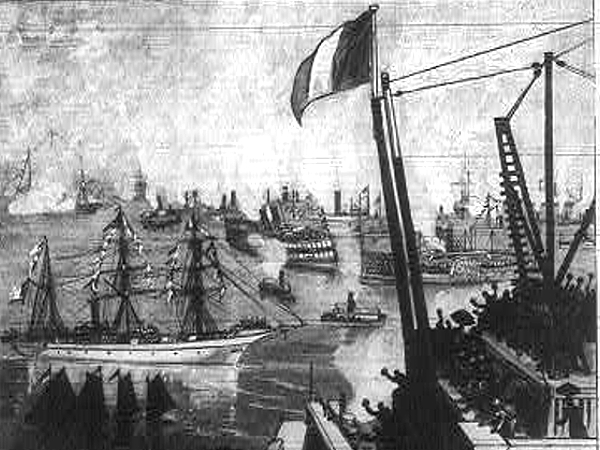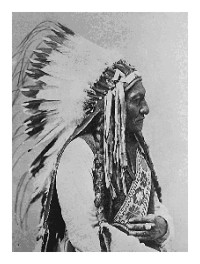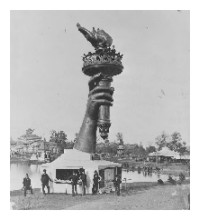Sponsor this page. Your banner or text ad can fill the space above.
Click here to Sponsor the page and how to reserve your ad.
-
Timeline
1885 - Detail
June 17, 1885 - The Statue of Liberty arrives for the first time in New York harbor.

It was a gift. It was a monumental work of art that had been crafted in Frederic Auguste Bartholdi's studio in Paris over twenty-one years and had made its rounds during construction as an exhibit at the Philadelphia Centennial Exhibition in 1876. But, finally, it was making its way toward the destination of Bedloe Island in New York Harbor to light the way for immigrants into the United States. On board the steamer Isere, the collosal statue was about to become one of the most iconic statues in the world, a tourist attraction and beacon welcoming those huddled masses that would come to the immigration centers of Castle Clinton and Ellis Island.
But how did it come to be? Edouard Rene' de Laboulay was a staunch supporter of the Union during the American Civil War, an abolitionist. He thought, somewhere within five years of the end of that conflict, depending on the source, that a large statue, gifted from the French people, that would honor the freedom and independence that that victory represented, was an appropriate and significant symbol. And, if it assisted the French into moving toward democracy, that was good, too.
Labouley discussed his project with Frederic Auguste Bartholdi, a noted sculptor, but events in France, including the Franco-Prussian War, caused a delay. In June 1871, Bartholdi came to the United States and approached wealthy Americans, and President U.S. Grant, about the project. He wanted to place the statue on Bedloe Island in the harbor of New York, which happened to be owned by the United States government. Bartholdi chose the goddess Libertas, who represented freedom, and selected a peaceful countenance, clothed in robes, and holding a torch to represent progress. Most of these choices did not focus on what is today's interpretation for many, that of liberty in immigration. These choices were made, at the time, focusing on the issue of the freedom of slaves. At the bottom of the statue, almost hidden by the robes, is a broken chain.
Public support was engaged with its exhibit at the Philadelphia World's Fair, the Centennial Exhibition, in 1876, when the torch and arm of the sculpture, now named Liberty Enlightening the World, marvelled its guests, as well as at the Paris World's Fair of 1878 to enlist French support. The Franco-American Union took up the cause, including a nineteen year old member, Theodore Roosevelt. Two hundred and fifty thousand francs were fundraised by 1879. By 1880, Bartholdi had enlisted the assistance of Gustave Eiffel. Yes, the man with that Paris tower. Two years later, the statue had been completed to its waist level. By July 4, 1884, it was finished, then presented to the United States ambassador, Levi P. Morton, in Paris. The French government would pay to transport the statue to its home in New York habor once the pedestal on Bedloe Island, now Liberty Island, was on its way to completion.

Buy Chronology

The Statue Arrives
The night before arrival at Bedloe Island, the steamer Isere had arrived outside Sandy Hook, with the statue. Captain Joseph Henderson was chosen to escort the French ship into the harbor the next day, June 17, 1885. Two hundred thousand residents of New York and New Jersey lined the shore to see the statue arrive. Although there had been difficulty fundraising on the American side to construct the pedestal, once the Statue of Liberty arrived, the fundraising and support for the statue was evident. On August 11, 1885, the New York World newspaper announced that $102,000 had been raised, with eighty percent coming from small donations under $1.
The pedestal was not complete, however, upon arrival, and the statue had to wait to be constructed until April 1886. On October 28, 1886, it was finally ready for dedication, with President Grover Cleveland presided. A parade was held in the city; hundreds of thousand to one million people attended. Only dignitaries were in attendance on the island itself during the dedication. Since that day, the Statue of Liberty, has been visited by millions each year, a National Park Service site since 1937.
News Report, Statue of Liberty Arrives
New York Herald, June 18, 1885
THE ISERE ARRIVES
Bartholdi's Statue of Liberty Brought to Anchor in the Port
RECEPTION CEREMONIES TO-MORROW
A Procession Up Broadway and Addresses at the City Hall
The French transport vessel Isere, with the
Bartholdi statue on board, arrived in this port yesterday. Pilot Joseph Henderson, of the pilot boat Pet, No. 10, ran across her about ten o'clock on Tuesday night, about ten miles outside
the lightship. She was unable to cross the bar, and remained outside until after five o'clock yesterday morning, when she steamed up and anchored in the horseshoe at Sandy Hook. When
the vessel came to anchor Captain de Saunne (sp?) sent the following telegram to General Stone, the acting secretary of the Bartholdi Statue Committee:-
Isere, carrying statue, waiting instructions to
remove. Answer immediately.
To this General Stoue sent the following reply:- A thousand welcomes. I will go to see you immediately.
General Stone and Agent de Bibian, of the French line of steamers, at once started for the Castle Garden dock, where a tag was in readiness to take them to the Isere. As they were about putting off President of the Board of Aldermen Adolph Sanger, who is also President of the Aldermanic Reception Committee, came running up to the stringpiees and jumped aboard. This was about ten o'clock in the forenoon. When they reached the Isere they found that they had been preceded by the
acting French Consul aud some other French gentlemen. A steam launch from the United States ship Omaha had also come down from the naval station at Gravesend, where the vessel wss anchored,
with an invitation to the Isere to come up to that anchor tee. Commander de Saunne's response to the invitation was that he should first reeeive the president of the American committee
When General Stone arrived he seconded the suggestion
of the Omaha's commander, and it was arranged that the Isere should proceed to Gravesend late in the afternoon.
CORDIAL GREETINGS.
The greeting between the visitors and those who had gone to meet them was naturally a cordial oue. Commander de Saunne took from a cabinet an elegantly engrossed presentation address signed by
Bartholdi and by Count Ferdinand de Lesseps chairman of the French committee, and handed it to General Stone, representing the American committee. It was in French on vellnm. At one side
was an illuminated white silk badge, with a picture of the statue upon it, and at the top the words, "La France a l'Amerique." This was known as the document of transfer. It read:-
GENTLEMEN: - The colossal statue of "Liberty Enlightening the World" is this morning embarked on the national ship Isere, and will goon arrive in its new fatherland. The French government has kindly joined in the work of the Franco-American Union, taking upon ltself its transportation.
The official flag of the French Republic thus comes to
complete the popular action and the great manifestation
of friendship for the countrymen of Lafayette. The
official transfer of the statue having been made to His
Excellency Mr. Morton, Minister Plenipotentiary of the
United States at Paris, we have tbe honor of recalling to you now the terms of this solemn act which, carrying the official signatures, has been confided to the hands of the representation of the Republic of the United States in the year 1884, on the 4th of July, on the anniversary of the American day of
independence, in the presence of M. Jues Kerry, President
of tbe Council of Ministers and Minister of Foregin Affairs, Count Kordinand de Lesseps, in the name of the Franco American Committee and the national manifestation of which that
committee has been the organ that has presented the colossal statue of Liberty Enlightening the World, the work of the sculptor Bartholdi, to Mr. Morton, Minister Plenipotentiary of the United States, requesting him to be the interpreter of tbe national sentiment of this work is the expression.
Mr. Morton, in the name of his countrymen, thanks the Franco-American Union for this testimonial of the sympathy of the French people. He declares that in virtue of the powers which have been conuded to him by the President of tbs United States the American committee represented by its president, Mr. William M. hvnris (sp?), he accepts the statue, and that it will be erected in conformity with the joint resolution of Congress on February 22, 1877, in the port of New York, as a beacon of the ancient friendship existing between the two nations.
[Signed]
In the name of France:-
JULES FERRY
BRISSON
President of the Chamber of Deputies.
MORTON.
In the name of the Franco-American Union Committee:-
FERDINAND DE LESSEPS.
E. DE LA FAYETTE.
COMPLIMENTS EXCHANGED.
Shortly before seven o'clock in the evening the Isere came to anchor off Graveseud, alongside the Omaha. Commander de Saunne at once had his gig lowered and paid a visit to tbe American commander. A number of steam yachts circled about the new arrival until sundown, each one as they passed firing a salute of one gun. When a HERALD reporter boarded her he found her officers deprecating the reception of visitors because of the rather unshipshape condition in which the vessel was as a consequence of her long journey, part of which had been very stormy. The worst weather during the trip was experienced in the run from Rouen to Fayal, which latter port she left on the 4th of this month, the entire trip occupying twenty-seven days. A bronzed sailor opened a hatchway and tbe reporter descended into one of the four compartments in which the parts of the statue are stored.
"This is one of the curls," he said, pointing to a
slatted box that was securely fastened above and below. The curl measured sixteen feet in length. There were 213 similar boxes
in the other compartments of the vessel, each holding a portion of the statue, the entire weight of which, when put together, will be 220 tons. From the nature of the cargo, however, it took up the whole 800 tons of room of the transport. It took fifteen days to pack and stow the statue.
THK ISERE AND HER OFFICERS.
The Isere is painted a dull white. This coating she received when she started for Touquin, some months ago, carrying troops. Her commander, Captain Lespinasse de Saunne, is a man somewhat
beyond middle age, wearing light side whiskers and mustache. His next in command is Lieutenant Arnet, a young, pleasant featured
man, with black, carefully trimmed beard and mustache. Sixty-five men compose the crew. Only the captain speaks English, aud he not very well. The men of the Isere will devote to-day to burnishing up their vessel preparatory to the ceremonies
of reception, which have been arranged for tomorrow.
THE RECEPTION CEREMONIES
The Board of Aldermen and the members of the American Committee and the Chamber of Commerce Committee are to start for Gravesend from the foot of Wall street, at nine o'clock, in the new ferryboat Atlantic, of the Union Ferry Company. After formal greetings on board of the Isere, a procession will
bo formed under command of Commodore Chandler, of the Navy Yard, consisting of the United States vessels Powhatan, Omaha aud Minnesota, the committee's boat, the Isere aud the French frigate La Flore. Mr. Louis de Bebian yesterday
received the following despatch from Admiral Lacombe, on board the La Flore, at Newport:-
Having received your despatch announcing the arrival of the Isere. I start immediately. Please inform the
Isere I will arrival at the bar at two P. M. Thursday.
When Bedloe's Island is reached the commander
of the Isere will land for the purpose of making
a preliminary formal transfer of his charge. He will then follow in the French admiral's yacht the rest of the flotilla
to the landing at the Battery. The Seventy-first, the Twelfth and the Sixty-ninth regiments will be at the Battery to receive the visitors. General Shaler will be in command of this division. There will also be in waiting there a force of mounted
police, a number of representatives of French societies and detachments of the Guards Rochambeau aud Lafayette. The procession will march up Broadway to the City Hall. At one o'clock there will be addresses in the Governor's Room by Mayor Grace. Mr. Frederick B. Coudert and General Stone. The address adopted at tbe last meeting of the Board of Aldermen will also be presented to the French officers. At two o'clock
there will be a luncheon in the Governor's Room.
Tho Governor's Boom aud Common Conncil Chamber were being decorated yesterday, and the windows and picture frames are draped with French and American flags. In the Common Council
Chamber the columns are twined with red, white and blue bunting. City Hall Gallery will be draped with bunting and the national colors of Frauce and the United States. A band of music
will be stationed on the balcony. The flags were
upon the City Hall poles yesterday.
On Tuesday the Chamber of Commerce is to give an excursion to the officers of the Isere, and on Wednesday the Chamber will give a banquet at Delmonico's. A tour of the public institutions on the islands will be made later.
Image above: Photo of the Isere (white ship center) and other boats in New York Harbor, 1885, Unknown author. Courtesy Wikipedia Commons. Below: Illustration of the Statue of Liberty arriving by the steamer Isere, 1885, Frank Leslie's Illustrated. Courtesy Library of Congress. Info Source: New York Herald; Wikipedia Commons; National Park Service; Library of Congress.







